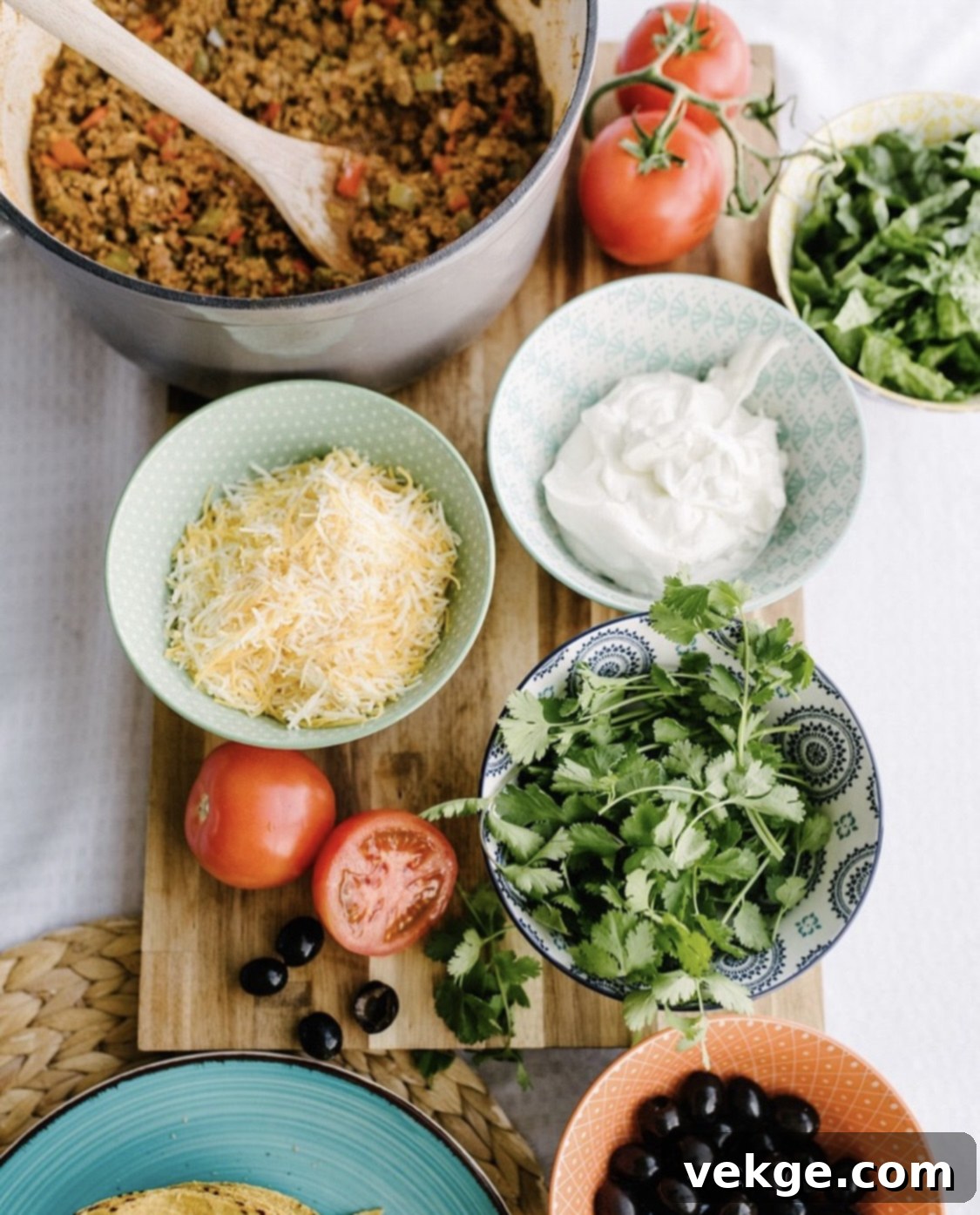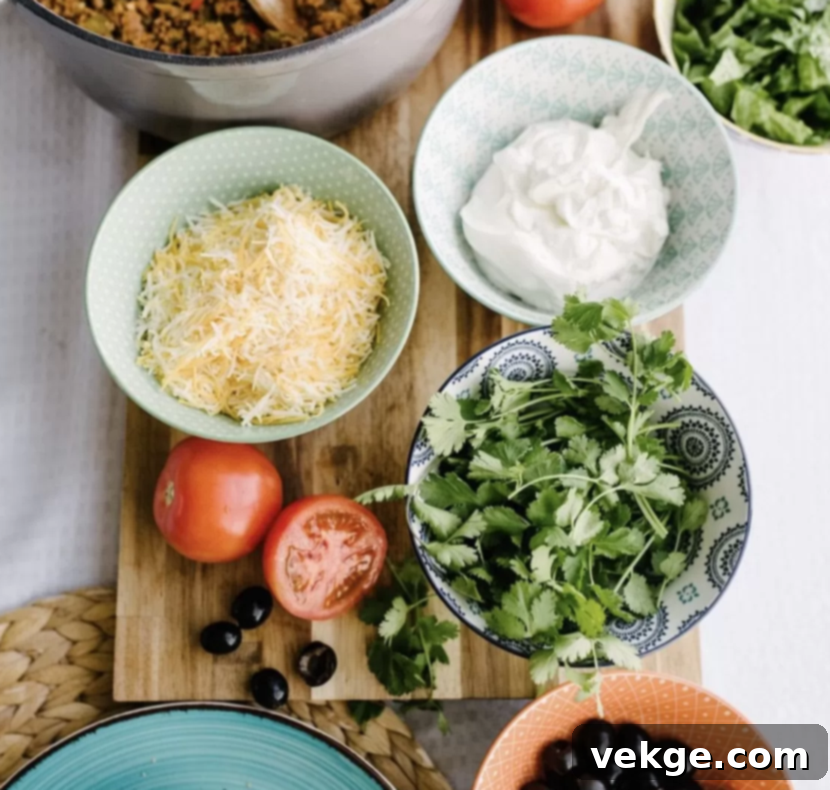Welcome to the only taco filling recipe you’ll ever need! For years, this particular blend has been my culinary cornerstone for all things Tex-Mex, and honestly, I haven’t even thought about trying another. It’s more than just a recipe; it’s a secret weapon in the kitchen, renowned for its incredible flavor, delightful texture, and a sneaky nutritional boost that makes every bite feel both indulgent and wholesome. This isn’t just for Tuesdays; this is your go-to for vibrant taco nights, hearty taco salads, and crispy tostadas.
What sets this taco filling apart from the rest is its brilliant incorporation of finely chopped vegetables. Yes, you read that right – hidden veggies! These aren’t just for adding bulk; they infuse the ground beef with an incredible depth of flavor and an extra dimension that elevates the entire dish. It’s a fantastic way to boost your daily vegetable intake without anyone, especially the kids, even noticing. The vegetables cook down beautifully, blending seamlessly into the savory ground beef mixture, contributing a natural sweetness and earthiness that packaged taco seasonings simply can’t replicate. Forget bland and one-dimensional fillings; prepare for a rich, complex, and utterly satisfying experience that will have everyone asking for seconds.

The Ultimate Ground Beef Taco Filling: A Family Favorite
This recipe isn’t just about making tacos; it’s about crafting a versatile, flavor-packed base that can transform into countless exciting meals. We’re talking about a filling that’s so good, you’ll want to make a double batch every time. The magic begins with high-quality ground beef, ideally grass-fed for a richer taste and better nutritional profile. Paired with a vibrant medley of finely diced onions, red bell peppers, and green bell peppers, plus aromatic minced garlic, this filling builds layers of flavor from the very first sizzle in the pan.
The beauty of the finely diced vegetables lies in their ability to almost “melt” into the meat, adding moisture, sweetness, and a subtle textural contrast without being overtly chunky. This technique is particularly excellent for anyone looking to incorporate more vegetables into their diet, or for parents dealing with picky eaters. The vibrant colors of the bell peppers also lend a beautiful hue to the finished dish, making it as appealing to the eye as it is to the palate.
Why This Taco Filling Recipe Stands Out
Beyond the hidden veggies, the carefully selected blend of spices is what truly makes this recipe shine. Chili powder and cumin are the stars, providing that quintessential Tex-Mex warmth and earthy aroma that signals a truly authentic taco experience. A touch of salt and pepper enhances all the natural flavors, while a spoon of tomato paste adds a crucial umami depth and richness, giving the sauce a beautiful body and color. Finally, a splash of water helps to create a luscious, simmered sauce that coats every morsel of meat and vegetable, ensuring every bite is bursting with flavor.
This combination of ingredients, cooked to perfection, creates a taco filling that is robust, savory, and incredibly satisfying. It avoids the artificial taste often found in pre-made taco seasoning packets, giving you a fresh, homemade flavor that’s hard to beat. The simmering process allows all these wonderful flavors to meld together, deepening the complexity and ensuring a truly memorable meal.
Beyond the Tortilla: Versatile Ways to Enjoy This Filling
While “taco” is in its name, this incredible filling’s versatility knows no bounds. It’s a culinary chameleon, ready to adapt to whatever craving strikes. Here are just a few ways you can enjoy this sensational ground beef and veggie mixture:
1. The Perfect Taco Salad
Transform your healthy eating efforts into a fiesta! Layer this warm, savory taco filling over a bed of crisp lettuce. Add your favorite toppings: shredded cheddar or Monterey Jack cheese, juicy diced tomatoes, sliced black olives, creamy avocado or guacamole, a dollop of cool sour cream, and a squeeze of fresh lime juice. A drizzle of zesty ranch dressing or a homemade cilantro-lime vinaigrette ties it all together for a satisfying and vibrant meal that’s both light and hearty.
2. Crispy and Delicious Tostadas
For a delightful crunch, spread a generous amount of the taco filling onto a crispy tostada shell. Top with refried beans, shredded lettuce, a sprinkle of cheese, and your preferred salsa for an open-faced taco experience that’s simple yet incredibly flavorful. The contrast between the warm filling and the cool, fresh toppings is simply irresistible.
3. Hearty Burritos and Burrito Bowls
Wrap this filling in large flour tortillas with rice, black beans, corn, salsa, and cheese for a classic, filling burrito. Or, ditch the tortilla and create a vibrant burrito bowl! Start with a base of cilantro-lime rice, add black beans, corn, a scoop of the taco filling, and all your favorite toppings like pico de gallo, avocado slices, and a dollop of Greek yogurt for a healthier sour cream alternative. This is perfect for meal prep and a healthier alternative to fast food.
4. Epic Nacho Platters
Elevate your snack game or casual dinner with an epic platter of nachos. Spread tortilla chips on a baking sheet, dollop generously with this taco filling, sprinkle with plenty of cheese, and bake until bubbly and golden. Once out of the oven, load up with fresh salsa, jalapeños, sour cream, and guacamole for a crowd-pleasing dish that’s perfect for game day or a fun family night.
5. Cheesy Quesadillas
For a quick and easy lunch or dinner, sandwich the taco filling between two tortillas with a generous amount of cheese. Grill in a hot pan until the tortillas are golden brown and the cheese is melted and gooey. Serve with salsa and sour cream for a delicious and satisfying meal.
6. Stuffed Bell Peppers
For an even more veggie-packed meal, halve some bell peppers (any color!), stuff them with the taco filling, top with cheese, and bake until the peppers are tender and the cheese is melted. This is a fantastic low-carb option that’s bursting with flavor.
The possibilities truly are endless. This recipe provides a solid, incredibly delicious foundation that encourages culinary creativity and ensures you’ll never get bored with your meals.

Taco Salad
Print
Pin
Rate
Ingredients
- 1 pound ground beef grass-fed always tastes best
- 1 small/medium white onion
- 1 red bell pepper
- 1 green bell pepper
- 2 cloves minced garlic
- 2 tsp chili powder
- 2 tsp cumin
- 1 tsp salt
- 1/4 tsp pepper
- 2 T tomato paste
- 1/2 cup water
Instructions
- Finely dice the onion and bell peppers. Mince garlic.
- In a hot frying pan, add the ground beef, onion, and bell peppers. Cook throughout, stirring often, breaking up the meat until it’s browned and crumbly.
- When the meat is cooked through and the onion is translucent, drain any excess fat from the pan. Then, add the minced garlic and cook for a couple of minutes, stirring constantly until fragrant.
- Reduce heat to low. Add the chili powder, cumin, salt, pepper, tomato paste, and water. Stir thoroughly to combine all the ingredients. Let the mixture simmer gently for a few minutes, allowing the flavors to meld and the sauce to thicken slightly.
- Serve your versatile taco filling! For a taco salad, spoon the filling over a bed of crisp greens, then top with cheese, lettuce, tomatoes, olives, avocado, sour cream, a squeeze of fresh lime juice, and a drizzle of ranch dressing. Alternatively, serve it in warm tortillas for classic tacos, roll it into burritos, or spread it over a crispy tostada for an open-faced delight. Get creative with your favorite toppings!
Tips for Taco Filling Success
Achieving the perfect taco filling is easy with a few simple tips:
- Quality Ingredients Matter: Starting with good quality ground beef (grass-fed, if possible, for superior flavor and nutrients) and fresh, vibrant vegetables will make a noticeable difference in the final taste.
- Dice Finely: For truly “hidden” veggies, ensure your onion and bell peppers are diced very finely. This allows them to soften and blend seamlessly into the meat mixture.
- Don’t Skimp on Simmering: The few minutes of simmering at the end are crucial. This is where the spices, tomato paste, and beef really get to know each other, developing a deeper, more cohesive flavor profile.
- Adjust Spice Levels: If you prefer more heat, don’t hesitate to add a pinch of cayenne pepper or a dash of your favorite hot sauce along with the other seasonings.
- Drain Excess Fat: After browning the beef and vegetables, draining any excess fat is important for a less greasy and more palatable filling.
- Meal Prep Friendly: This taco filling is excellent for meal prepping. Cook a large batch, let it cool completely, then store it in an airtight container in the refrigerator for up to 3-4 days or freeze it for up to 3 months. It reheats beautifully, making for quick and easy weeknight meals.
Elevate Your Taco Experience with Perfect Toppings
The right toppings can transform a great taco into an extraordinary one. Here’s a comprehensive list of suggested accompaniments to ensure every bite is bursting with flavor and texture:
- Fresh Vegetables: Shredded lettuce (iceberg or romaine for crunch), diced tomatoes, chopped red onion, fresh cilantro, sliced radishes, or pickled jalapeños.
- Creamy Additions: Sour cream, Greek yogurt (as a healthier alternative), guacamole, or sliced avocado.
- Cheeses: Shredded cheddar, Monterey Jack, a Mexican blend, or crumbled cotija cheese.
- Salsas: Classic tomato salsa, pico de gallo (fresh salsa), salsa verde, corn salsa, or a fruity mango salsa for a sweet and savory kick.
- Citrus: Fresh lime wedges are a must! A squeeze of lime juice brightens all the flavors.
- Beans: Black beans or refried beans can be added as a side or directly into burritos/bowls.
- Heat: Your favorite hot sauce for an extra kick!
By offering a variety of toppings, you can cater to everyone’s preferences, making mealtime interactive and fun. Encourage guests and family members to build their own custom tacos, salads, or bowls.
Final Thoughts: Your New Go-To Recipe
This ground beef taco filling recipe is more than just a meal; it’s a celebration of fresh ingredients, vibrant flavors, and culinary versatility. It’s the kind of recipe that becomes a staple in your kitchen, known for its consistent deliciousness and ease of preparation. Whether you’re a seasoned chef or a novice cook, you’ll find joy in how simple yet profoundly flavorful this dish is.
So, clear your kitchen, gather your ingredients, and get ready to experience the best taco filling you’ve ever made. Say goodbye to boring dinners and hello to a world of delicious possibilities. This recipe isn’t just about feeding your family; it’s about creating memorable meals, one flavorful bite at a time. Enjoy!
